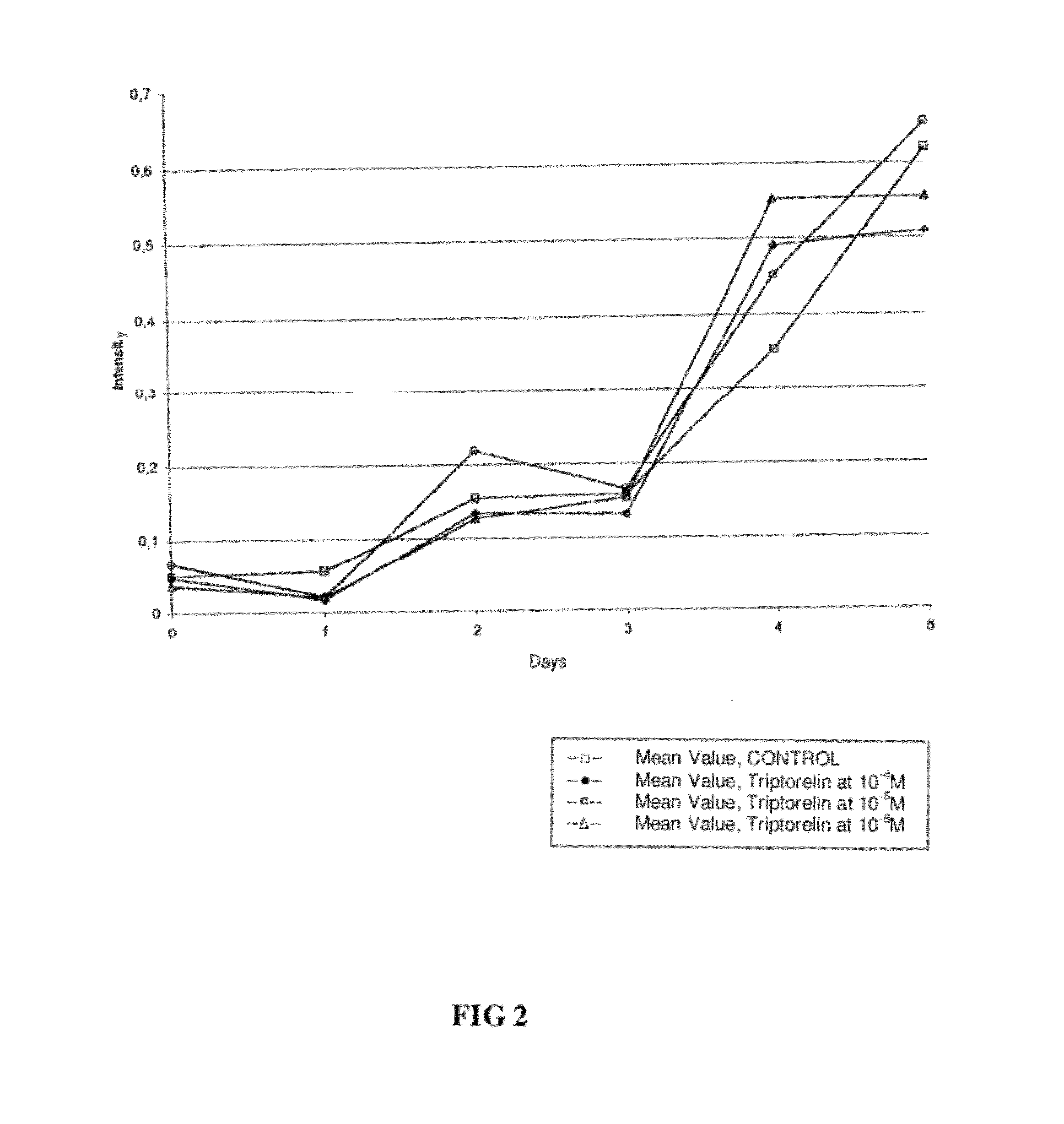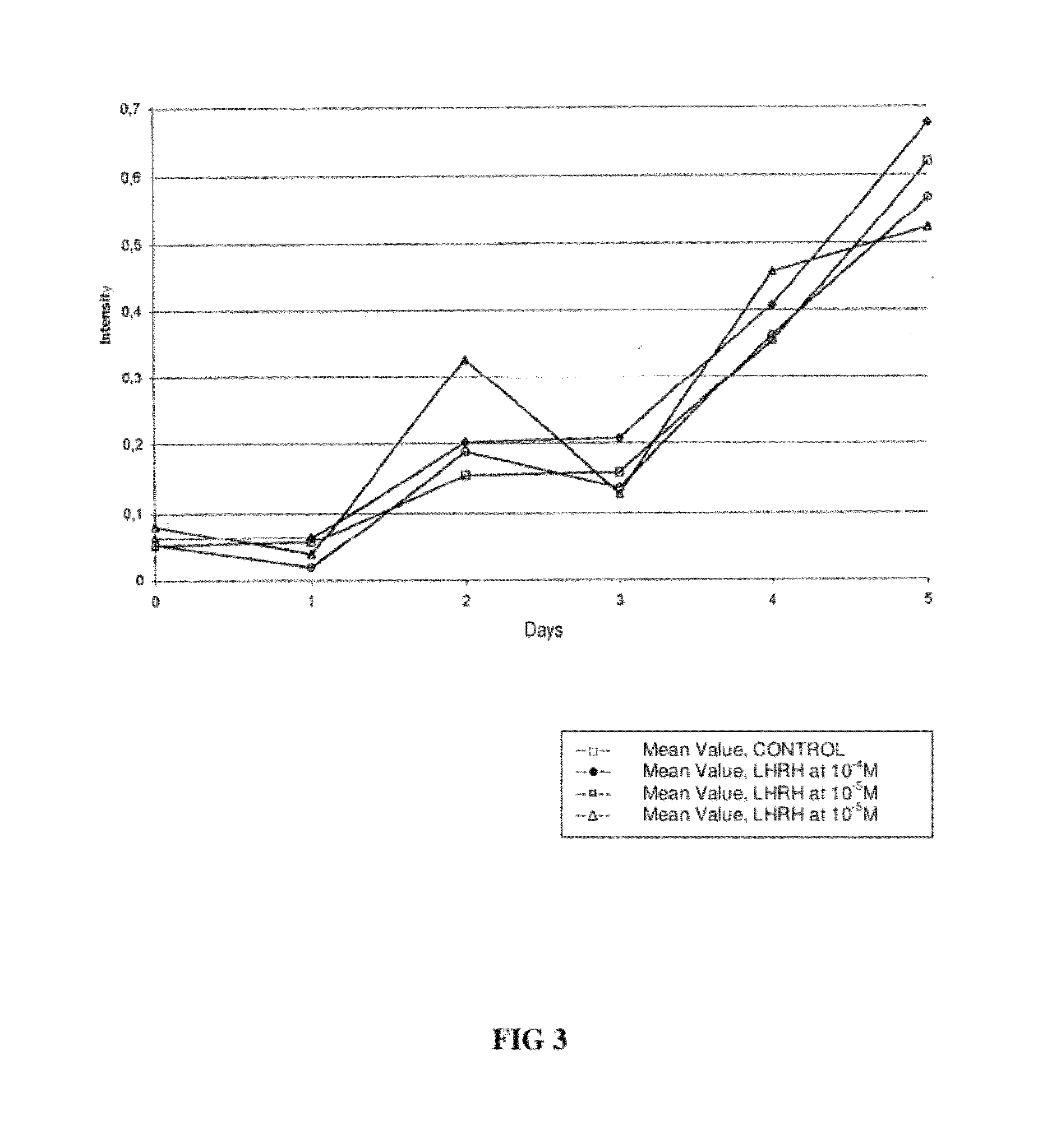Methods for reducing GnRH-positive tumor cell proliferation using the GnRH antagonist IN3
a technology of gnrh and tumor cell, applied in the field of tumor diagnosis and therapy, can solve the problems of poor prognosis different forms of chemotherapy, radiotherapy, etc., and the prognosis quod vitam of patients with glioblastoma multiforme remains poor
- Summary
- Abstract
- Description
- Claims
- Application Information
AI Technical Summary
Benefits of technology
Problems solved by technology
Method used
Image
Examples
example 1
Determination of the Concentration of GnRH Receptors
[0075]One method for determining the concentration of GnRH receptors in cell membrane extracts that are derived from various cell lines and / or cell cultures is the Decapeptyl® radio receptor assay (described by Emons, G., et al., 1993, Cancer Research 53, 5439-5446). According to this protocol, GnRH receptor concentration is determined on a human cell line, such as the human glioblastoma cell line U-87 MG or U-373MG (Pinski et al., 1994, Cancer Research 54, 5895-5901). In this assay, the low affinity / high capacity as well as the high affinity / low capacity GnRH receptor binding sites are evaluated. Significant anti-proliferative effects were observed in these particular cell lines, similar to effects previously shown for the cell lines EFO-21 and EFO-27 (Emons, G., et al., supra).
[0076]Another method for determining GnRH receptor concentration on cell membrane extracts of cell lines and / or cell cultures is the LHRH radio receptor as...
example 2
Determination of the mRNA of GnRH Receptors by Means of RT-PCR
[0079]One method for determining GnRH receptor messenger RNA is by means of reverse transcriptase polymerase chain reaction (RT-PCR). For example, in a first reaction, RNA derived from the glioblastoma cell line U-87 MG or U-373MG is transcribed to cDNA. In a further reaction, for example, the 884 bp fragment of the pituitary GnRH receptor (Kakar, S., et al., Biochem. Biophys. Res. Comm., 1992, 289-295) or of the placental GnRH receptor (Leung, P. C. K., Biological Signals, 1996, 5, 63-69) or of the placental GnRH receptor gene (Lin, L., et al., J. Clinical Endocrinol. Metabolism, 1995, vol. 80, No. 2, 581-584) is amplified using specific primers in a RT-PCT, wherein the cDNA of a known GnRH receptor-positive cell line serves as the positive control. Then, the reaction products are visualized in a polyacrylamide (PAA) gel. On the PAA gel, it can be observed: in lane 1, the fragment length marker; in lane 2, a clear band o...
example 3
Therapeutic In Vitro Study
[0080]Proliferation Assay on Cell Cultures
[0081]A human cell line, such as the well known human glioblastoma cell lines U-87MG or U-373MG (Pinski et al., supra), or a human cell line such as the well known Kaposi sarcoma cell lines KSY-1 or KS-SLK (Parkash et al., 1996, New England Journal of Medicine, 335, 17, 1261-1269), or a human cell line such as the well known human malignant melanoma cell line MV3 or BLM (Goldbrunner, R. H., et al., 1996, Anticancer Research 16 (6B), 3679-87), or a human medulloblastoma cell line such as the well known cell line Daoy or D283 MED (Stockhammer et al., 1995, J. Neurosurgery, 83, 672-681), or human meningeoma cell cultures (Boyle-Wash, E., et al., 1995, Journal of Endocrinology, 145, 155-161), are cultured as previously described for the above-mentioned cell lines and then treated with a concentration of the GnRH agonist Triptorelin®, GnRH antagonist SB-75 (Cetrorelix®) or GnRH antagonist Ramorelix®. Significant anti-pro...
PUM
| Property | Measurement | Unit |
|---|---|---|
| survival time | aaaaa | aaaaa |
| width | aaaaa | aaaaa |
| width | aaaaa | aaaaa |
Abstract
Description
Claims
Application Information
 Login to View More
Login to View More - R&D
- Intellectual Property
- Life Sciences
- Materials
- Tech Scout
- Unparalleled Data Quality
- Higher Quality Content
- 60% Fewer Hallucinations
Browse by: Latest US Patents, China's latest patents, Technical Efficacy Thesaurus, Application Domain, Technology Topic, Popular Technical Reports.
© 2025 PatSnap. All rights reserved.Legal|Privacy policy|Modern Slavery Act Transparency Statement|Sitemap|About US| Contact US: help@patsnap.com



